Abstract
This review of the clinical features of Huntington's disease incorporates recent developments in pathophysiology, preclinical diagnosis and treatment. Although the mechanism initiating and guiding the cell destruction in this illness is currently unknown, the excitatory neurotoxin and the energy metabolism models may provide a valuable direction for future research. Similarly, although the precise relation between the neuroanatomical damage in Huntington's disease and the functional disability is not clear, applications of recently developed neural connection models have implicated a number of important brain-behavior associations. Preclinical diagnostic procedures have evolved through successive iterations that have each contributed to increased reliability. New functional brain imaging techniques are sure to add to this promising domain in the future. Preclinical diagnosis has been stimulated by the recent isolation of the Huntington's gene which has also rekindled awareness of the importance of informed genetic counselling and the inherent ethical dilemmas in genetic testing. Treatment approaches to Huntington's disease have been confined to palliative care with secondary symptom management and psychotherapeutic support. Experimental therapeutic strategies for the illness itself have had a rather disappointing record to date. Further developments in NMDA antagonism and neural cell grafting may provide some hope for the future.
Full text
PDF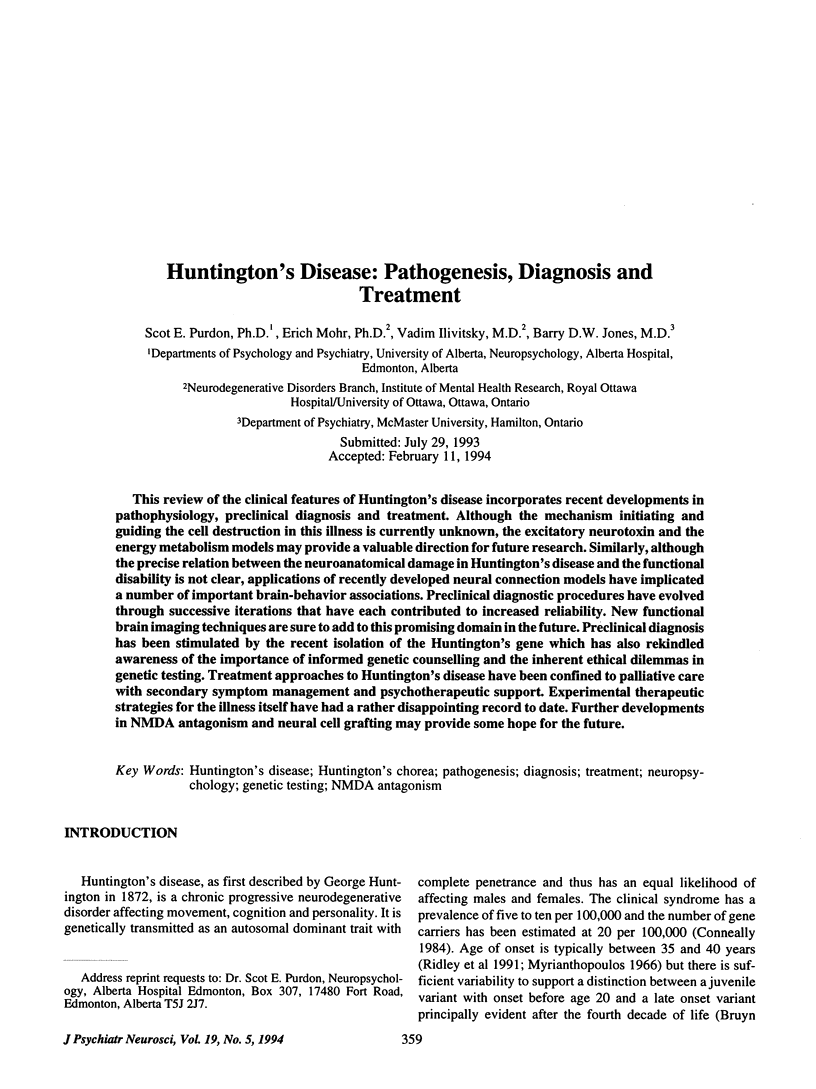
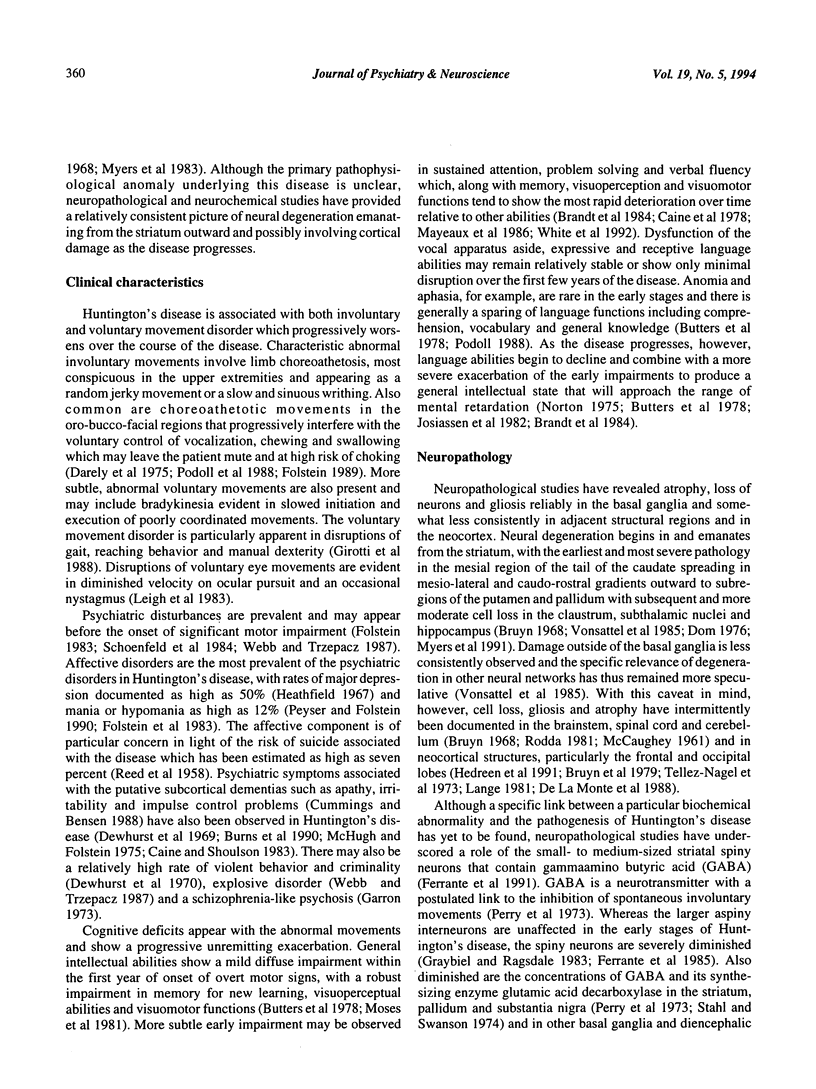
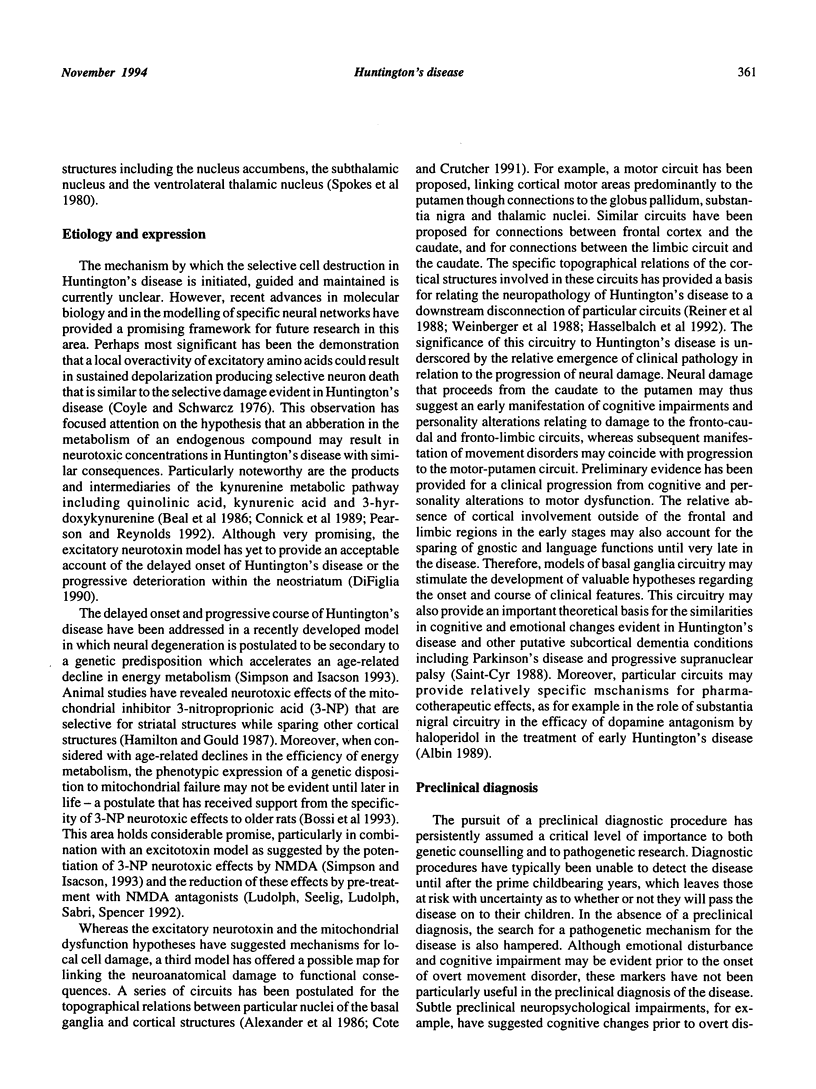
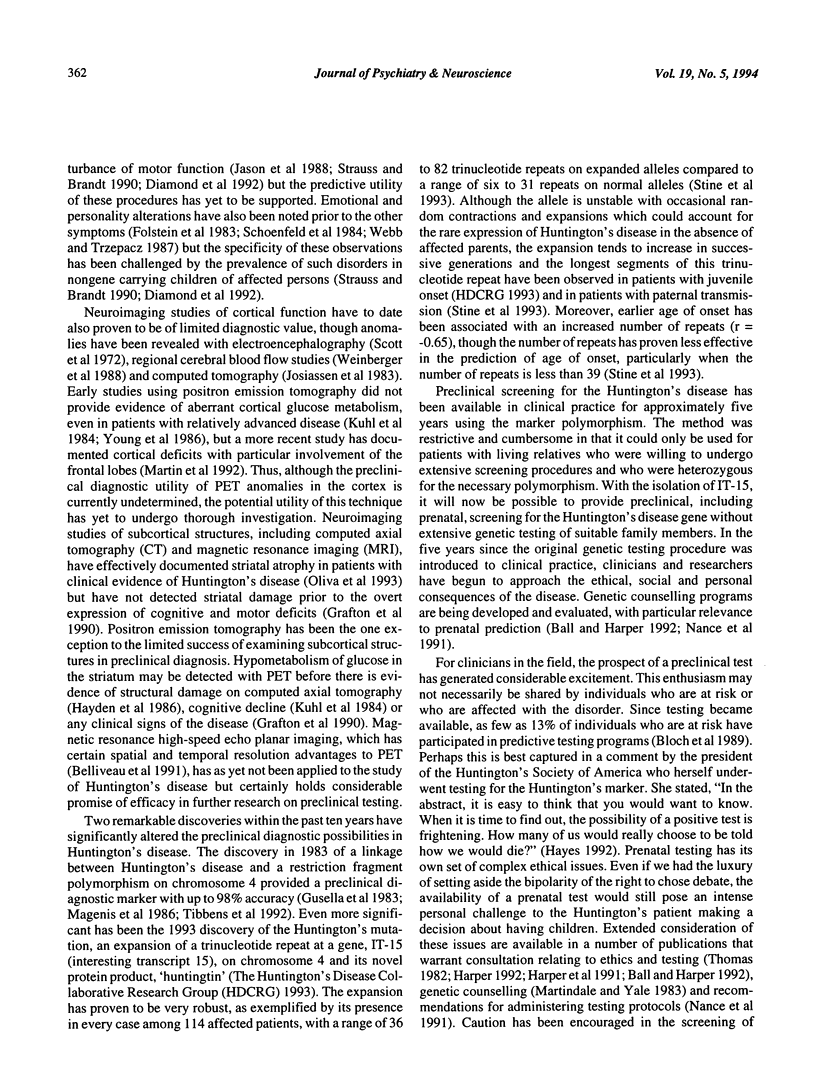
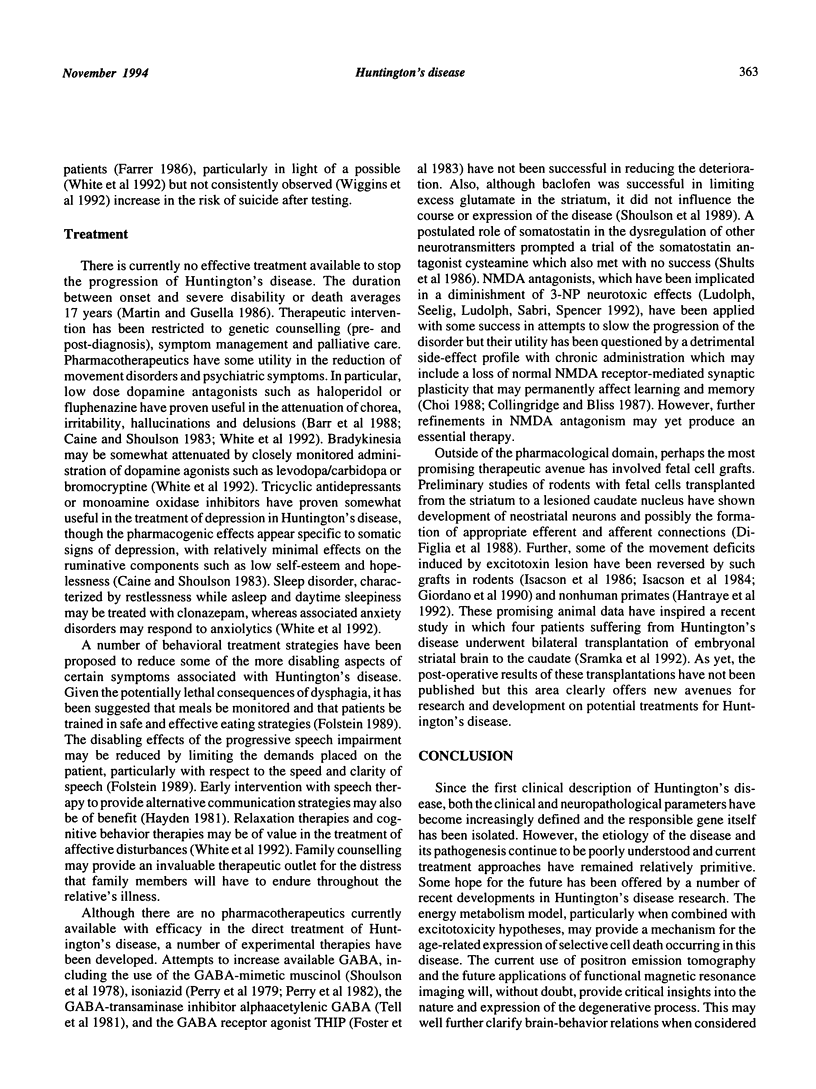
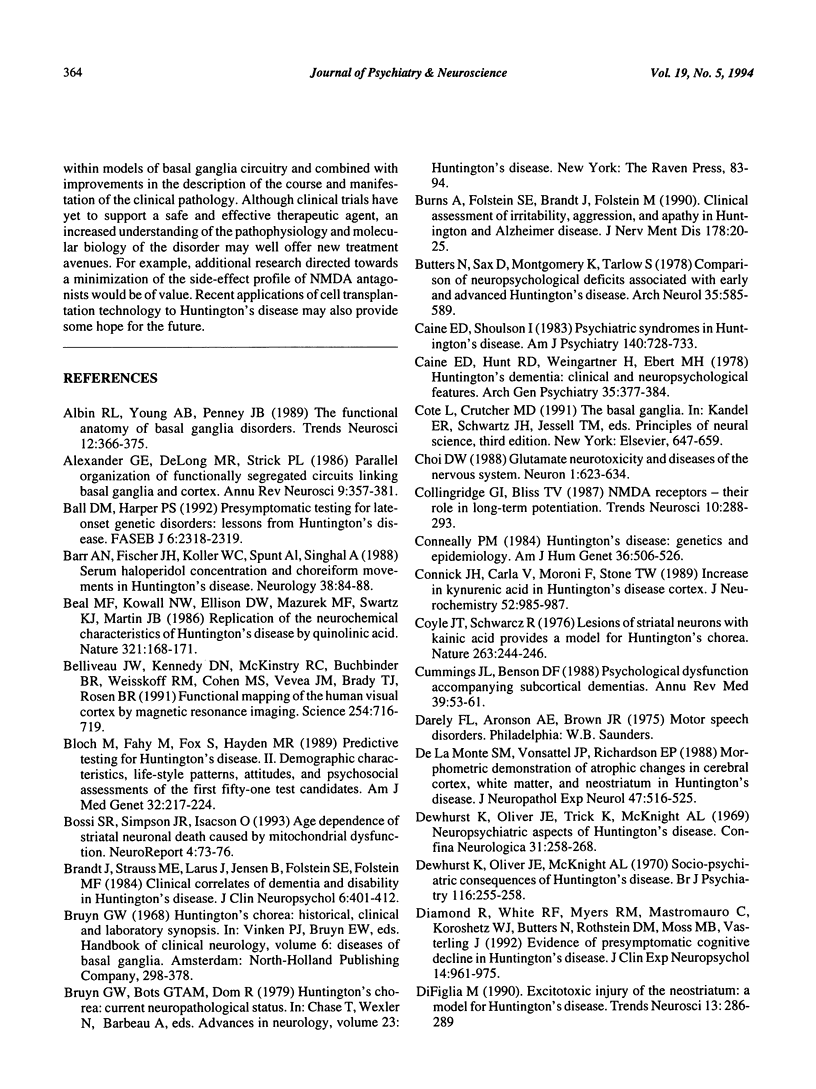
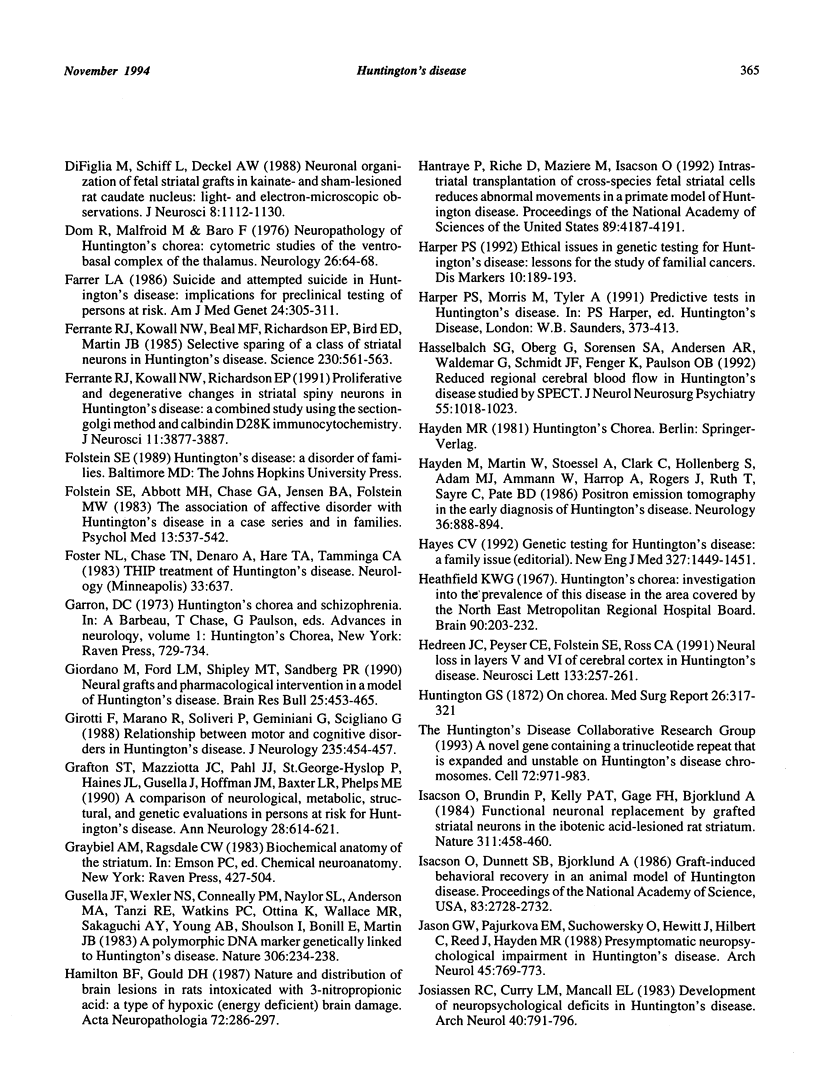
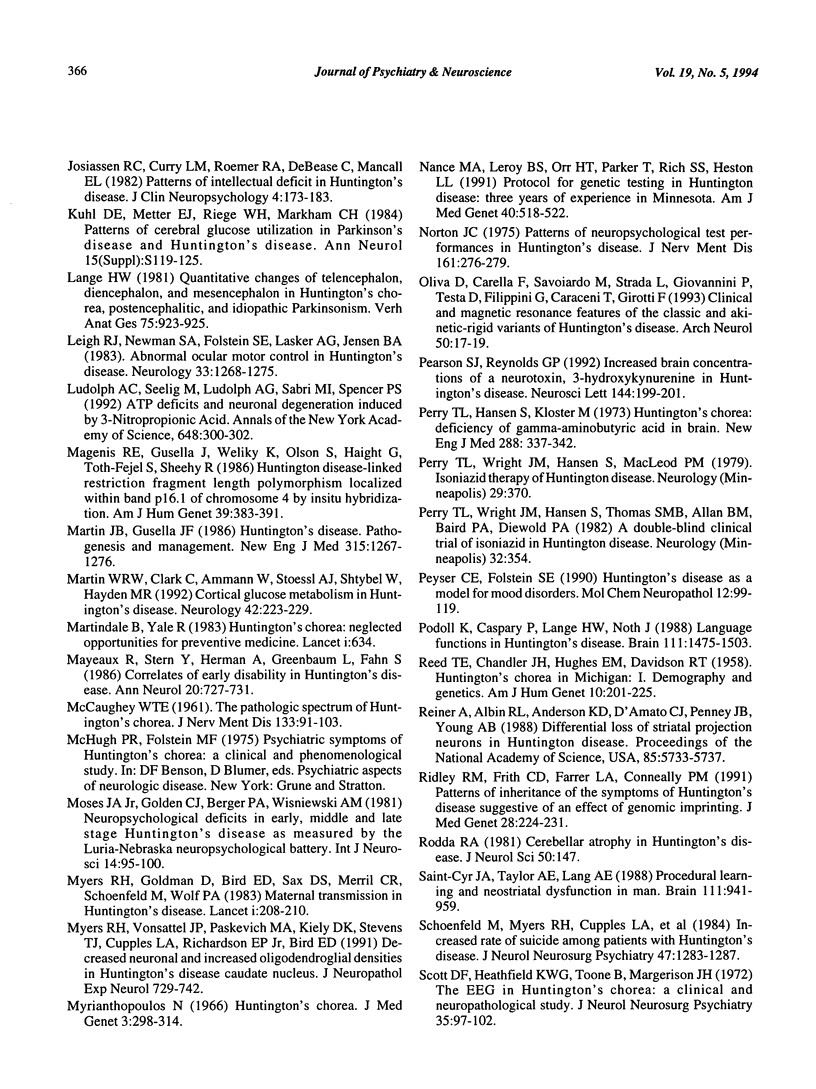
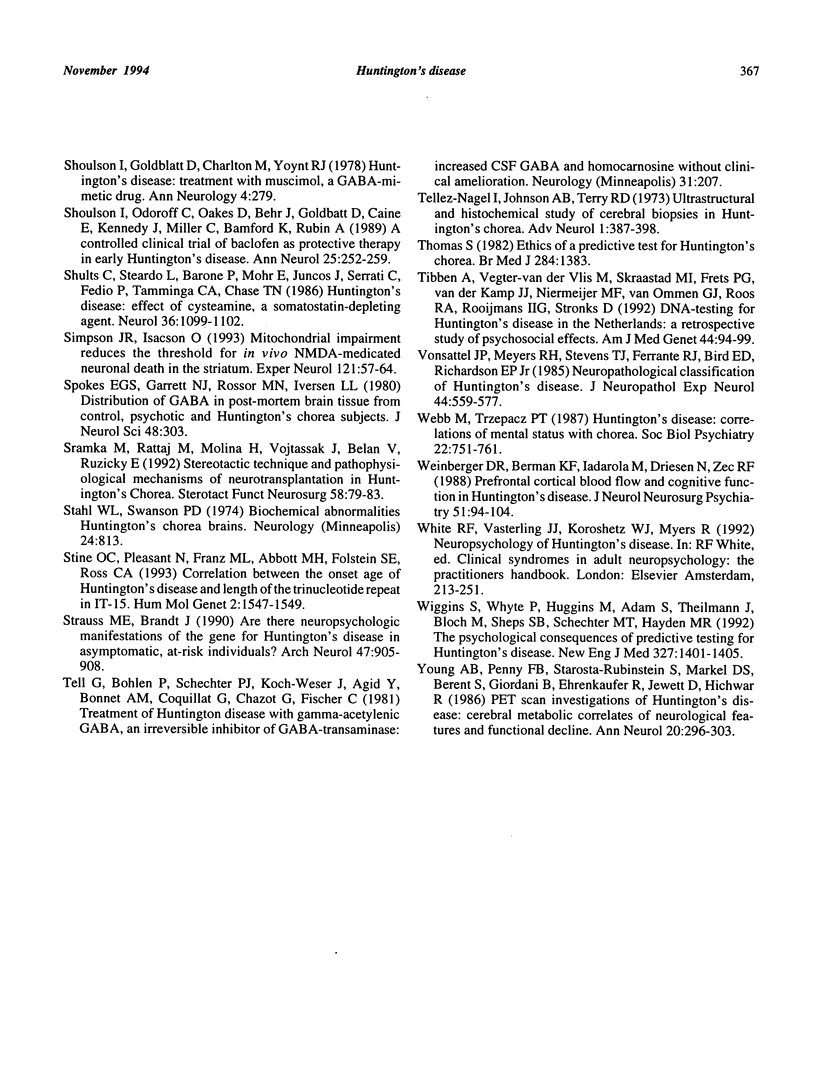
Selected References
These references are in PubMed. This may not be the complete list of references from this article.
- Albin R. L., Young A. B., Penney J. B. The functional anatomy of basal ganglia disorders. Trends Neurosci. 1989 Oct;12(10):366–375. doi: 10.1016/0166-2236(89)90074-x. [DOI] [PubMed] [Google Scholar]
- Alexander G. E., DeLong M. R., Strick P. L. Parallel organization of functionally segregated circuits linking basal ganglia and cortex. Annu Rev Neurosci. 1986;9:357–381. doi: 10.1146/annurev.ne.09.030186.002041. [DOI] [PubMed] [Google Scholar]
- Barr A. N., Fischer J. H., Koller W. C., Spunt A. L., Singhal A. Serum haloperidol concentration and choreiform movements in Huntington's disease. Neurology. 1988 Jan;38(1):84–88. doi: 10.1212/wnl.38.1.84. [DOI] [PubMed] [Google Scholar]
- Beal M. F., Kowall N. W., Ellison D. W., Mazurek M. F., Swartz K. J., Martin J. B. Replication of the neurochemical characteristics of Huntington's disease by quinolinic acid. Nature. 1986 May 8;321(6066):168–171. doi: 10.1038/321168a0. [DOI] [PubMed] [Google Scholar]
- Belliveau J. W., Kennedy D. N., Jr, McKinstry R. C., Buchbinder B. R., Weisskoff R. M., Cohen M. S., Vevea J. M., Brady T. J., Rosen B. R. Functional mapping of the human visual cortex by magnetic resonance imaging. Science. 1991 Nov 1;254(5032):716–719. doi: 10.1126/science.1948051. [DOI] [PubMed] [Google Scholar]
- Bloch M., Fahy M., Fox S., Hayden M. R. Predictive testing for Huntington disease: II. Demographic characteristics, life-style patterns, attitudes, and psychosocial assessments of the first fifty-one test candidates. Am J Med Genet. 1989 Feb;32(2):217–224. doi: 10.1002/ajmg.1320320215. [DOI] [PubMed] [Google Scholar]
- Bossi S. R., Simpson J. R., Isacson O. Age dependence of striatal neuronal death caused by mitochondrial dysfunction. Neuroreport. 1993 Jan;4(1):73–76. doi: 10.1097/00001756-199301000-00019. [DOI] [PubMed] [Google Scholar]
- Brandt J., Strauss M. E., Larus J., Jensen B., Folstein S. E., Folstein M. F. Clinical correlates of dementia and disability in Huntington's disease. J Clin Neuropsychol. 1984 Nov;6(4):401–412. doi: 10.1080/01688638408401231. [DOI] [PubMed] [Google Scholar]
- Butters N., Sax D., Montgomery K., Tarlow S. Comparison of the neuropsychological deficits associated with early and advanced Huntington's disease. Arch Neurol. 1978 Sep;35(9):585–589. doi: 10.1001/archneur.1978.00500330033006. [DOI] [PubMed] [Google Scholar]
- Caine E. D., Hunt R. D., Weingartner H., Ebert M. H. Huntington's dementia. Clinical and neuropsychological features. Arch Gen Psychiatry. 1978 Mar;35(3):377–384. doi: 10.1001/archpsyc.1978.01770270127013. [DOI] [PubMed] [Google Scholar]
- Caine E. D., Shoulson I. Psychiatric syndromes in Huntington's disease. Am J Psychiatry. 1983 Jun;140(6):728–733. doi: 10.1176/ajp.140.6.728. [DOI] [PubMed] [Google Scholar]
- Choi D. W. Glutamate neurotoxicity and diseases of the nervous system. Neuron. 1988 Oct;1(8):623–634. doi: 10.1016/0896-6273(88)90162-6. [DOI] [PubMed] [Google Scholar]
- Conneally P. M. Huntington disease: genetics and epidemiology. Am J Hum Genet. 1984 May;36(3):506–526. [PMC free article] [PubMed] [Google Scholar]
- Connick J. H., Carlà V., Moroni F., Stone T. W. Increase in kynurenic acid in Huntington's disease motor cortex. J Neurochem. 1989 Mar;52(3):985–987. doi: 10.1111/j.1471-4159.1989.tb02552.x. [DOI] [PubMed] [Google Scholar]
- Coyle J. T., Schwarcz R. Lesion of striatal neurones with kainic acid provides a model for Huntington's chorea. Nature. 1976 Sep 16;263(5574):244–246. doi: 10.1038/263244a0. [DOI] [PubMed] [Google Scholar]
- Cummings J. L., Benson D. F. Psychological dysfunction accompanying subcortical dementias. Annu Rev Med. 1988;39:53–61. doi: 10.1146/annurev.me.39.020188.000413. [DOI] [PubMed] [Google Scholar]
- Dewhurst K., Oliver J. E., McKnight A. L. Socio-psychiatric consequences of Huntington's disease. Br J Psychiatry. 1970 Mar;116(532):255–258. doi: 10.1192/bjp.116.532.255. [DOI] [PubMed] [Google Scholar]
- Dewhurst K., Oliver J., Trick K. L., McKnight A. L. Neuro-psychiatric aspects of Huntington's disease. Confin Neurol. 1969;31(4):258–268. doi: 10.1159/000103486. [DOI] [PubMed] [Google Scholar]
- DiFiglia M. Excitotoxic injury of the neostriatum: a model for Huntington's disease. Trends Neurosci. 1990 Jul;13(7):286–289. doi: 10.1016/0166-2236(90)90111-m. [DOI] [PubMed] [Google Scholar]
- DiFiglia M., Schiff L., Deckel A. W. Neuronal organization of fetal striatal grafts in kainate- and sham-lesioned rat caudate nucleus: light- and electron-microscopic observations. J Neurosci. 1988 Apr;8(4):1112–1130. doi: 10.1523/JNEUROSCI.08-04-01112.1988. [DOI] [PMC free article] [PubMed] [Google Scholar]
- Diamond R., White R. F., Myers R. H., Mastromauro C., Koroshetz W. J., Butters N., Rothstein D. M., Moss M. B., Vasterling J. Evidence of presymptomatic cognitive decline in Huntington's disease. J Clin Exp Neuropsychol. 1992 Nov;14(6):961–975. doi: 10.1080/01688639208402547. [DOI] [PubMed] [Google Scholar]
- Dom R., Malfroid M., Baro F. Neuropathology of Huntington's chorea. Studies of the ventrobasal complex of the thalamus. Neurology. 1976 Jan;26(1):64–68. doi: 10.1212/wnl.26.1.64. [DOI] [PubMed] [Google Scholar]
- Farrer L. A. Suicide and attempted suicide in Huntington disease: implications for preclinical testing of persons at risk. Am J Med Genet. 1986 Jun;24(2):305–311. doi: 10.1002/ajmg.1320240211. [DOI] [PubMed] [Google Scholar]
- Ferrante R. J., Kowall N. W., Beal M. F., Richardson E. P., Jr, Bird E. D., Martin J. B. Selective sparing of a class of striatal neurons in Huntington's disease. Science. 1985 Nov 1;230(4725):561–563. doi: 10.1126/science.2931802. [DOI] [PubMed] [Google Scholar]
- Ferrante R. J., Kowall N. W., Richardson E. P., Jr Proliferative and degenerative changes in striatal spiny neurons in Huntington's disease: a combined study using the section-Golgi method and calbindin D28k immunocytochemistry. J Neurosci. 1991 Dec;11(12):3877–3887. doi: 10.1523/JNEUROSCI.11-12-03877.1991. [DOI] [PMC free article] [PubMed] [Google Scholar]
- Folstein S., Abbott M. H., Chase G. A., Jensen B. A., Folstein M. F. The association of affective disorder with Huntington's disease in a case series and in families. Psychol Med. 1983 Aug;13(3):537–542. doi: 10.1017/s0033291700047966. [DOI] [PubMed] [Google Scholar]
- Foster N. L., Chase T. N., Denaro A., Hare T. A., Tamminga C. A. THIP treatment of Huntington's disease. Neurology. 1983 May;33(5):637–639. doi: 10.1212/wnl.33.5.637. [DOI] [PubMed] [Google Scholar]
- Giordano M., Ford L. M., Shipley M. T., Sanberg P. R. Neural grafts and pharmacological intervention in a model of Huntington's disease. Brain Res Bull. 1990 Sep;25(3):453–465. doi: 10.1016/0361-9230(90)90238-u. [DOI] [PubMed] [Google Scholar]
- Girotti F., Marano R., Soliveri P., Geminiani G., Scigliano G. Relationship between motor and cognitive disorders in Huntington's disease. J Neurol. 1988 Nov;235(8):454–457. doi: 10.1007/BF00314246. [DOI] [PubMed] [Google Scholar]
- Grafton S. T., Mazziotta J. C., Pahl J. J., St George-Hyslop P., Haines J. L., Gusella J., Hoffman J. M., Baxter L. R., Phelps M. E. A comparison of neurological, metabolic, structural, and genetic evaluations in persons at risk for Huntington's disease. Ann Neurol. 1990 Nov;28(5):614–621. doi: 10.1002/ana.410280503. [DOI] [PubMed] [Google Scholar]
- Gusella J. F., Wexler N. S., Conneally P. M., Naylor S. L., Anderson M. A., Tanzi R. E., Watkins P. C., Ottina K., Wallace M. R., Sakaguchi A. Y. A polymorphic DNA marker genetically linked to Huntington's disease. Nature. 1983 Nov 17;306(5940):234–238. doi: 10.1038/306234a0. [DOI] [PubMed] [Google Scholar]
- Hamilton B. F., Gould D. H. Nature and distribution of brain lesions in rats intoxicated with 3-nitropropionic acid: a type of hypoxic (energy deficient) brain damage. Acta Neuropathol. 1987;72(3):286–297. doi: 10.1007/BF00691103. [DOI] [PubMed] [Google Scholar]
- Hantraye P., Riche D., Maziere M., Isacson O. Intrastriatal transplantation of cross-species fetal striatal cells reduces abnormal movements in a primate model of Huntington disease. Proc Natl Acad Sci U S A. 1992 May 1;89(9):4187–4191. doi: 10.1073/pnas.89.9.4187. [DOI] [PMC free article] [PubMed] [Google Scholar]
- Harper P. Ethical issues in genetic testing for Huntington's disease: lessons for the study of familial cancers. Dis Markers. 1992 Jul-Aug;10(4):189–228. [PubMed] [Google Scholar]
- Hasselbalch S. G., Oberg G., Sørensen S. A., Andersen A. R., Waldemar G., Schmidt J. F., Fenger K., Paulson O. B. Reduced regional cerebral blood flow in Huntington's disease studied by SPECT. J Neurol Neurosurg Psychiatry. 1992 Nov;55(11):1018–1023. doi: 10.1136/jnnp.55.11.1018. [DOI] [PMC free article] [PubMed] [Google Scholar]
- Hayden M. R., Martin W. R., Stoessl A. J., Clark C., Hollenberg S., Adam M. J., Ammann W., Harrop R., Rogers J., Ruth T. Positron emission tomography in the early diagnosis of Huntington's disease. Neurology. 1986 Jul;36(7):888–894. doi: 10.1212/wnl.36.7.888. [DOI] [PubMed] [Google Scholar]
- Hayes C. V. Genetic testing for Huntington's disease--a family issue. N Engl J Med. 1992 Nov 12;327(20):1449–1451. doi: 10.1056/NEJM199211123272008. [DOI] [PubMed] [Google Scholar]
- Heathfield K. W. Huntington's chorea. Investigation into the prevalence of this disease in the area covered by the North East Metropolitan Regional Hospital Board. Brain. 1967 Mar;90(1):203–232. doi: 10.1093/brain/90.1.203. [DOI] [PubMed] [Google Scholar]
- Hedreen J. C., Peyser C. E., Folstein S. E., Ross C. A. Neuronal loss in layers V and VI of cerebral cortex in Huntington's disease. Neurosci Lett. 1991 Dec 9;133(2):257–261. doi: 10.1016/0304-3940(91)90583-f. [DOI] [PubMed] [Google Scholar]
- Isacson O., Brundin P., Kelly P. A., Gage F. H., Björklund A. Functional neuronal replacement by grafted striatal neurones in the ibotenic acid-lesioned rat striatum. Nature. 1984 Oct 4;311(5985):458–460. doi: 10.1038/311458a0. [DOI] [PubMed] [Google Scholar]
- Isacson O., Dunnett S. B., Björklund A. Graft-induced behavioral recovery in an animal model of Huntington disease. Proc Natl Acad Sci U S A. 1986 Apr;83(8):2728–2732. doi: 10.1073/pnas.83.8.2728. [DOI] [PMC free article] [PubMed] [Google Scholar]
- Jason G. W., Pajurkova E. M., Suchowersky O., Hewitt J., Hilbert C., Reed J., Hayden M. R. Presymptomatic neuropsychological impairment in Huntington's disease. Arch Neurol. 1988 Jul;45(7):769–773. doi: 10.1001/archneur.1988.00520310079021. [DOI] [PubMed] [Google Scholar]
- Josiassen R. C., Curry L. M., Mancall E. L. Development of neuropsychological deficits in Huntington's disease. Arch Neurol. 1983 Dec;40(13):791–796. doi: 10.1001/archneur.1983.04050120041005. [DOI] [PubMed] [Google Scholar]
- Josiassen R. C., Curry L., Roemer R. A., DeBease C., Mancall E. L. Patterns of intellectual deficit in Huntington's disease. J Clin Neuropsychol. 1982 Jul;4(2):173–183. doi: 10.1080/01688638208401127. [DOI] [PubMed] [Google Scholar]
- Leigh R. J., Newman S. A., Folstein S. E., Lasker A. G., Jensen B. A. Abnormal ocular motor control in Huntington's disease. Neurology. 1983 Oct;33(10):1268–1275. doi: 10.1212/wnl.33.10.1268. [DOI] [PubMed] [Google Scholar]
- Ludolph A. C., Seelig M., Ludolph A. G., Sabri M. I., Spencer P. S. ATP deficits and neuronal degeneration induced by 3-nitropropionic acid. Ann N Y Acad Sci. 1992 May 11;648:300–302. doi: 10.1111/j.1749-6632.1992.tb24562.x. [DOI] [PubMed] [Google Scholar]
- Magenis R. E., Gusella J., Weliky K., Olson S., Haight G., Toth-Fejel S., Sheehy R. Huntington disease-linked restriction fragment length polymorphism localized within band p16.1 of chromosome 4 by in situ hybridization. Am J Hum Genet. 1986 Sep;39(3):383–391. [PMC free article] [PubMed] [Google Scholar]
- Martin J. B., Gusella J. F. Huntington's disease. Pathogenesis and management. N Engl J Med. 1986 Nov 13;315(20):1267–1276. doi: 10.1056/NEJM198611133152006. [DOI] [PubMed] [Google Scholar]
- Martin W. R., Clark C., Ammann W., Stoessl A. J., Shtybel W., Hayden M. R. Cortical glucose metabolism in Huntington's disease. Neurology. 1992 Jan;42(1):223–229. doi: 10.1212/wnl.42.1.223. [DOI] [PubMed] [Google Scholar]
- Martindale B., Yale R. Huntington's chorea: neglected opportunities for preventive medicine. Lancet. 1983 Mar 19;1(8325):634–636. doi: 10.1016/s0140-6736(83)91803-2. [DOI] [PubMed] [Google Scholar]
- Mayeux R., Stern Y., Herman A., Greenbaum L., Fahn S. Correlates of early disability in Huntington's disease. Ann Neurol. 1986 Dec;20(6):727–731. doi: 10.1002/ana.410200613. [DOI] [PubMed] [Google Scholar]
- Myers R. H., Goldman D., Bird E. D., Sax D. S., Merril C. R., Schoenfeld M., Wolf P. A. Maternal transmission in Huntington's disease. Lancet. 1983 Jan 29;1(8318):208–210. doi: 10.1016/s0140-6736(83)92587-4. [DOI] [PubMed] [Google Scholar]
- Myers R. H., Vonsattel J. P., Paskevich P. A., Kiely D. K., Stevens T. J., Cupples L. A., Richardson E. P., Jr, Bird E. D. Decreased neuronal and increased oligodendroglial densities in Huntington's disease caudate nucleus. J Neuropathol Exp Neurol. 1991 Nov;50(6):729–742. doi: 10.1097/00005072-199111000-00005. [DOI] [PubMed] [Google Scholar]
- Myrianthopoulos N. C. Huntington's chorea. J Med Genet. 1966 Dec;3(4):298–314. doi: 10.1136/jmg.3.4.298. [DOI] [PMC free article] [PubMed] [Google Scholar]
- Nance M. A., Leroy B. S., Orr H. T., Parker T., Rich S. S., Heston L. L. Protocol for genetic testing in Huntington disease: three years of experience in Minnesota. Am J Med Genet. 1991 Sep 15;40(4):518–522. doi: 10.1002/ajmg.1320400431. [DOI] [PubMed] [Google Scholar]
- Norton J. C. Patterns of neuropsychological test performance in Huntington's disease. J Nerv Ment Dis. 1975 Oct;161(4):276–279. doi: 10.1097/00005053-197510000-00007. [DOI] [PubMed] [Google Scholar]
- Oliva D., Carella F., Savoiardo M., Strada L., Giovannini P., Testa D., Filippini G., Caraceni T., Girotti F. Clinical and magnetic resonance features of the classic and akinetic-rigid variants of Huntington's disease. Arch Neurol. 1993 Jan;50(1):17–19. doi: 10.1001/archneur.1993.00540010013010. [DOI] [PubMed] [Google Scholar]
- Pearson S. J., Reynolds G. P. Increased brain concentrations of a neurotoxin, 3-hydroxykynurenine, in Huntington's disease. Neurosci Lett. 1992 Sep 14;144(1-2):199–201. doi: 10.1016/0304-3940(92)90749-w. [DOI] [PubMed] [Google Scholar]
- Perry T. L., Hansen S., Kloster M. Huntington's chorea. Deficiency of gamma-aminobutyric acid in brain. N Engl J Med. 1973 Feb 15;288(7):337–342. doi: 10.1056/NEJM197302152880703. [DOI] [PubMed] [Google Scholar]
- Perry T. L., Wright J. M., Hansen S., MacLeod P. M. Isoniazid therapy of Huntington disease. Neurology. 1979 Mar;29(3):370–375. doi: 10.1212/wnl.29.3.370. [DOI] [PubMed] [Google Scholar]
- Perry T. L., Wright J. M., Hansen S., Thomas S. M., Allan B. M., Baird P. A., Diewold P. A. A double-blind clinical trial of isoniazid in Huntington disease. Neurology. 1982 Apr;32(4):354–358. doi: 10.1212/wnl.32.4.354. [DOI] [PubMed] [Google Scholar]
- Peyser C. E., Folstein S. E. Huntington's disease as a model for mood disorders. Clues from neuropathology and neurochemistry. Mol Chem Neuropathol. 1990 Mar;12(2):99–119. doi: 10.1007/BF03160062. [DOI] [PubMed] [Google Scholar]
- Podoll K., Caspary P., Lange H. W., Noth J. Language functions in Huntington's disease. Brain. 1988 Dec;111(Pt 6):1475–1503. doi: 10.1093/brain/111.6.1475. [DOI] [PubMed] [Google Scholar]
- REED T. E., CHANDLER J. H. Huntington's chorea in Michigan. I. Demography and genetics. Am J Hum Genet. 1958 Jun;10(2):201–225. [PMC free article] [PubMed] [Google Scholar]
- Reiner A., Albin R. L., Anderson K. D., D'Amato C. J., Penney J. B., Young A. B. Differential loss of striatal projection neurons in Huntington disease. Proc Natl Acad Sci U S A. 1988 Aug;85(15):5733–5737. doi: 10.1073/pnas.85.15.5733. [DOI] [PMC free article] [PubMed] [Google Scholar]
- Ridley R. M., Frith C. D., Farrer L. A., Conneally P. M. Patterns of inheritance of the symptoms of Huntington's disease suggestive of an effect of genomic imprinting. J Med Genet. 1991 Apr;28(4):224–231. doi: 10.1136/jmg.28.4.224. [DOI] [PMC free article] [PubMed] [Google Scholar]
- Rodda R. A. Cerebellar atrophy in Huntington's disease. J Neurol Sci. 1981 Apr;50(1):147–157. doi: 10.1016/0022-510x(81)90049-6. [DOI] [PubMed] [Google Scholar]
- Saint-Cyr J. A., Taylor A. E., Lang A. E. Procedural learning and neostriatal dysfunction in man. Brain. 1988 Aug;111(Pt 4):941–959. doi: 10.1093/brain/111.4.941. [DOI] [PubMed] [Google Scholar]
- Schoenfeld M., Myers R. H., Cupples L. A., Berkman B., Sax D. S., Clark E. Increased rate of suicide among patients with Huntington's disease. J Neurol Neurosurg Psychiatry. 1984 Dec;47(12):1283–1287. doi: 10.1136/jnnp.47.12.1283. [DOI] [PMC free article] [PubMed] [Google Scholar]
- Scott D. F., Heathfield K. W., Toone B., Margerison J. H. The EEG in Huntington's chorea: a clinical and neuropathological study. J Neurol Neurosurg Psychiatry. 1972 Feb;35(1):97–102. doi: 10.1136/jnnp.35.1.97. [DOI] [PMC free article] [PubMed] [Google Scholar]
- Shoulson I., Goldblatt D., Charlton M., Joynt R. J. Huntington's disease: treatment with muscimol, a GABA-mimetic drug. Ann Neurol. 1978 Sep;4(3):279–284. doi: 10.1002/ana.410040316. [DOI] [PubMed] [Google Scholar]
- Shoulson I., Odoroff C., Oakes D., Behr J., Goldblatt D., Caine E., Kennedy J., Miller C., Bamford K., Rubin A. A controlled clinical trial of baclofen as protective therapy in early Huntington's disease. Ann Neurol. 1989 Mar;25(3):252–259. doi: 10.1002/ana.410250308. [DOI] [PubMed] [Google Scholar]
- Shults C., Steardo L., Barone P., Mohr E., Juncos J., Serrati C., Fedio P., Tamminga C. A., Chase T. N. Huntington's disease: effect of cysteamine, a somatostatin-depleting agent. Neurology. 1986 Aug;36(8):1099–1102. doi: 10.1212/wnl.36.8.1099. [DOI] [PubMed] [Google Scholar]
- Simpson J. R., Isacson O. Mitochondrial impairment reduces the threshold for in vivo NMDA-mediated neuronal death in the striatum. Exp Neurol. 1993 May;121(1):57–64. doi: 10.1006/exnr.1993.1071. [DOI] [PubMed] [Google Scholar]
- Spokes E. G., Garrett N. J., Rossor M. N., Iversen L. L. Distribution of GABA in post-mortem brain tissue from control, psychotic and Huntington's chorea subjects. J Neurol Sci. 1980 Dec;48(3):303–313. doi: 10.1016/0022-510x(80)90103-3. [DOI] [PubMed] [Google Scholar]
- Sramka M., Rattaj M., Molina H., Vojtassák J., Belan V., Ruzický E. Stereotactic technique and pathophysiological mechanisms of neurotransplantation in Huntington's chorea. Stereotact Funct Neurosurg. 1992;58(1-4):79–83. doi: 10.1159/000098976. [DOI] [PubMed] [Google Scholar]
- Stahl W. L., Swanson P. D. Biochemical abnormalities in Huntington's chorea brains. Neurology. 1974 Sep;24(9):813–819. doi: 10.1212/wnl.24.9.813. [DOI] [PubMed] [Google Scholar]
- Stine O. C., Pleasant N., Franz M. L., Abbott M. H., Folstein S. E., Ross C. A. Correlation between the onset age of Huntington's disease and length of the trinucleotide repeat in IT-15. Hum Mol Genet. 1993 Oct;2(10):1547–1549. doi: 10.1093/hmg/2.10.1547. [DOI] [PubMed] [Google Scholar]
- Strauss M. E., Brandt J. Are there neuropsychologic manifestations of the gene for Huntington's disease in asymptomatic, at-risk individuals? Arch Neurol. 1990 Aug;47(8):905–908. doi: 10.1001/archneur.1990.00530080093016. [DOI] [PubMed] [Google Scholar]
- Tell G., Böhlen P., Schechter P. J., Koch-Weser J., Agid Y., Bonnet A. M., Coquillat G., Chazot G., Fischer C. Treatment of Huntington disease with gamma-acetylenic GABA an irreversible inhibitor of GABA-transaminase: increased CSF GABA and homocarnosine without clinical amelioration. Neurology. 1981 Feb;31(2):207–211. doi: 10.1212/wnl.31.2.207. [DOI] [PubMed] [Google Scholar]
- Thomas S. Ethics of a predictive test for Huntington's chorea. Br Med J (Clin Res Ed) 1982 May 8;284(6326):1383–1385. doi: 10.1136/bmj.284.6326.1383. [DOI] [PMC free article] [PubMed] [Google Scholar]
- Tibben A., Vegter-van der Vlis M., Skraastad M. I., Frets P. G., van der Kamp J. J., Niermeijer M. F., van Ommen G. J., Roos R. A., Rooijmans H. G., Stronks D. DNA-testing for Huntington's disease in The Netherlands: a retrospective study on psychosocial effects. Am J Med Genet. 1992 Sep 1;44(1):94–99. doi: 10.1002/ajmg.1320440122. [DOI] [PubMed] [Google Scholar]
- Vonsattel J. P., Myers R. H., Stevens T. J., Ferrante R. J., Bird E. D., Richardson E. P., Jr Neuropathological classification of Huntington's disease. J Neuropathol Exp Neurol. 1985 Nov;44(6):559–577. doi: 10.1097/00005072-198511000-00003. [DOI] [PubMed] [Google Scholar]
- Webb M., Trzepacz P. T. Huntington's disease: correlations of mental status with chorea. Biol Psychiatry. 1987 Jun;22(6):751–761. doi: 10.1016/0006-3223(87)90207-1. [DOI] [PubMed] [Google Scholar]
- Weinberger D. R., Berman K. F., Iadarola M., Driesen N., Zec R. F. Prefrontal cortical blood flow and cognitive function in Huntington's disease. J Neurol Neurosurg Psychiatry. 1988 Jan;51(1):94–104. doi: 10.1136/jnnp.51.1.94. [DOI] [PMC free article] [PubMed] [Google Scholar]
- Wiggins S., Whyte P., Huggins M., Adam S., Theilmann J., Bloch M., Sheps S. B., Schechter M. T., Hayden M. R. The psychological consequences of predictive testing for Huntington's disease. Canadian Collaborative Study of Predictive Testing. N Engl J Med. 1992 Nov 12;327(20):1401–1405. doi: 10.1056/NEJM199211123272001. [DOI] [PubMed] [Google Scholar]
- Young A. B., Penney J. B., Starosta-Rubinstein S., Markel D. S., Berent S., Giordani B., Ehrenkaufer R., Jewett D., Hichwa R. PET scan investigations of Huntington's disease: cerebral metabolic correlates of neurological features and functional decline. Ann Neurol. 1986 Sep;20(3):296–303. doi: 10.1002/ana.410200305. [DOI] [PubMed] [Google Scholar]
- de la Monte S. M., Vonsattel J. P., Richardson E. P., Jr Morphometric demonstration of atrophic changes in the cerebral cortex, white matter, and neostriatum in Huntington's disease. J Neuropathol Exp Neurol. 1988 Sep;47(5):516–525. doi: 10.1097/00005072-198809000-00003. [DOI] [PubMed] [Google Scholar]


